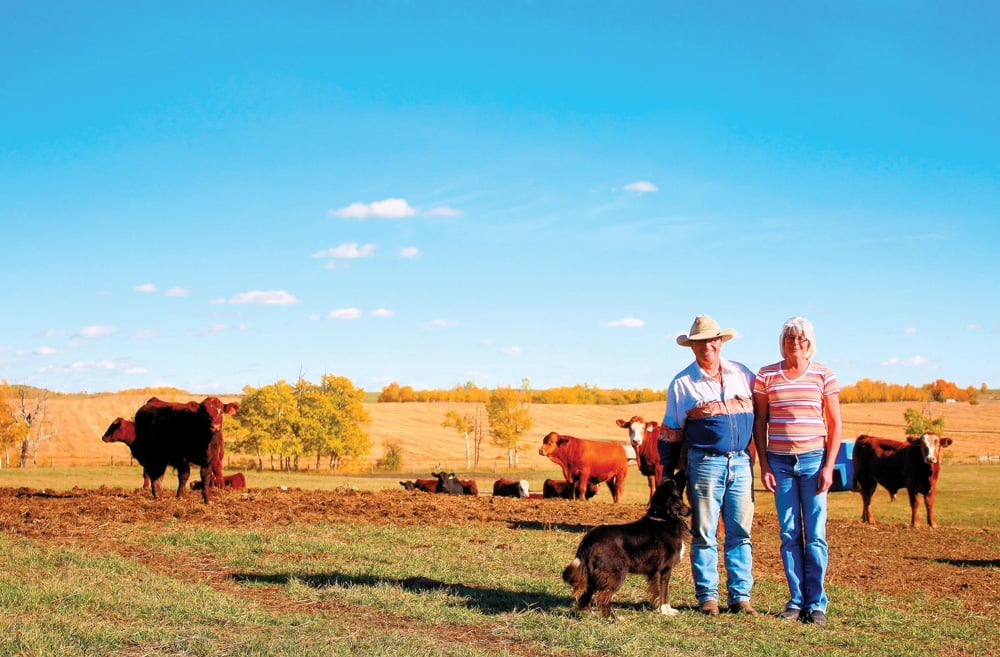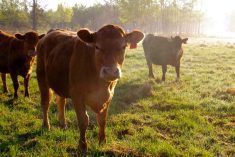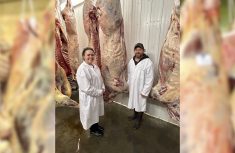It won’t be the sandy beaches that draw Grant and Tanya Chittick south to Mexico for the winter. When they do make the trip on their own time, it will be to visit the ranches that are home to breeding stock purchased from the family’s ranch north of Mayerthorpe, Alta.
Chittick received word September 28 that the 33 bred Red Angus heifers shipped four days earlier had arrived at the Mexican border. The Chittick heifers, along with seven of his neighbour’s and 40 from two ranches in Saskatchewan made up the two loads of 80 bred Red Angus heifers that left Canada in sealed cattle liners. They were unloaded in Wyoming for a 24-hour rest and health check before reloading onto the liners that were resealed by that veterinarian for takeoff to the Mexican border. There, they were off-loaded and rested for 48 hours for the final jaunt on domestic liners bound for the ranch near Hermosillo, capital of Sonora state in northwestern Mexico, about six hours south of Phoenix.
Read Also

Body condition, nutrition and vaccination for brood cows
One of the remarkable events of the past century related to ranching has been the genetic evolution of brood cows….
The sale was arranged and co-ordinated by Roger Peters of Peterosa Exports at Red Deer, Alta., who first did business with the Chitticks when a Mexican buyer purchased a bred Hereford heifer from their son, Raymond, at Farmfair International (FFI) in Edmonton.
Through connections made at FFI, several potential buyers and the president of the Asociacion Angus Mexicana, Billy Estrada, have come up to the ranch a couple of times lately looking at cattle, Chittick says.
“The Mexicans are looking for lines to improve their beef genetics and mainly look for easy-going cattle with good conformation and feet,” Chittick explains. They do take notice of performance as indicated by size and looked at the sires’ papers, but never asked for performance records on the heifers. They won’t even consider animals with short ears because that’s taken as an indication that the animal has been or is sick. To stay true to the Red Angus breed, they might accept a bit of white on the udder, but not a hair in front.
The registration papers were transferred to the new owner in Mexico. Now all calves off the heifers next spring, and every year thereafter, will be inspected by officials of Mexico’s Angus association to make sure they meet requirements for registration there.
The sale went smoothly with Peters arranging and accounting for preg checking, health tests and other export requirements as well as transportation.
Chittick was hopeful that some of the farm’s Simmental heifers would fit the bill for orders from Mexican buyers that Peters was looking to fill. The family raises fullblood, Red and Black Simmentals, but the Mexicans are only interested in the fullbloods, he adds.
The Chittick family includes four clans who live in close proximity to one another and each have their own herds. They work together running 600 registered Simmental, Red and Black Angus, and Hereford cows on a total land base of 15 deeded quarters and additional rented land to provide all of their grazing and winter feed needs.
Their annual Chittick Family Bull Sale is the first Friday of March at Mayerthorpe. Drought this summer cut short their plan to go ahead with their first production sale for bred heifers. Normally, they raise 170 bred heifers and keep about 100. This year, they will be selling 100 and the sale to Mexico got them off to an early start.
Grant, his wife, Tanya, and their son, Raymond, have 450 Red and Black Angus, Red and fullblood Simmental, and Hereford cows. Their youngest son, Jessie, has added a few of his own and their daughter, Crystal, helps where needed and with the paperwork that goes along with having registered cattle. Grant and Tanya operate under the name, Gra-Tan Farm, and Raymond goes by Chittick Farm.
The Black Simmental herd is owned by Grant’s parents, Gary and Faye, who go by the old Irish name, Kin-Kin Farm, along with Grant’s brother, Randy, and wife, Donna, who call their place Rachido.
Those who take in Farmfair may be most familiar with the Chittick Family Herefords name.
Hereford was the original breed on the farm in his granddad’s and dad’s earlier years, Grant says. They branched out into other breeds in recent years as Continental cattle were making their mark and the Angus breed was stepping out with strong promotions, but still maintain a herd of 100 Hereford cows. Chittick likes to showcase the Herefords at FFI to boost the breed’s image and is very pleased to see the Hereford association pick up the pace with new research and promotions.
In addition to the Hereford heifer sold through the FFI venue, the family took home the reserve champion ribbon with a group of three yearling Hereford bulls in the 2014 all-breed pen of bulls show judged by commercial ranchers.
Raymond’s bull was the rancher’s choice pick at the Hereford genes event as well. Sponsored by the Canadian Hereford Association, this event is open to all Hereford breeders showing at FFI who pay to enter a bull calf or yearling bull and invite five customers. The lucky customer is drawn during the Ranch Rodeo where all of the bulls are displayed. The owner of the rancher’s choice bull receives payment from the association, which was $10,000 last year.
“Farmfair has been a great way of promoting our cattle,” Chittick says, adding that all four families participated with 15 Hereford and Simmental cattle entered in this year’s show, November 11-15.
The Chitticks also hosted a stop during FFI’s farm and industry tour day, Nov. 10, as part of its inbound-buyers program co-ordinated with Canadian breeders and genetics companies to assist international buyers.
That wasn’t long after their return from the 2015 World Angus Secretariat’s conference and ranch tours hosted by Mexico in October. Their spot on the Durango leg of the tour ending at Mazatlan for the conference was made possible on the basis of all three qualifiers: through their participation in FFI, as a member of the Canadian Angus Association, and as an exporter.
For more information call Chitticks at 780-786-2181.
Red hot in Mexico
Roger Peters of Peterosa Exports has sold a fair share of purebred Simmental, Charolais, Hereford, Gelbvieh, Limousin, and Black Angus cattle to Mexican buyers over his 30-year career dealing in that market. Now, Red Angus is the hot breed there.
“Red Angus has been a relatively small breed in Mexico until now,” Peters says. About five years ago he saw demand for the breed start to pick up and last year sold approximately 300 bred heifers and yearling heifers and bulls to Mexican clients, making up close to half of his sales to the country that year.
“Mexicans appreciate the quality of our cattle and they adapt well into the climates there, depending on where they are from here, where they are going and management of the ranch in Mexico,” says Peters. Through the years, he has sold beef cattle from Western Canada, Ontario and the U.S. into 17 Mexican states and travelled 31 states building rapport with clients and learning about their needs.
Mexico is far more diverse than the fun-in-the-sun resorts seen in advertisements. Climates range from tropical to desert to mountains and all degrees in between with many beautiful, well-managed ranches, from extensive to intensive operations, he says. Just as
in Canada, ranches vary in size and scope depending on growing conditions. In some regions operations are expansive requiring maybe 100 acres per cow, while other places might be able to carry five cows on 10 acres.
Cattle he has shipped to the hot, dry northwest where the Chitticks’ cattle now are, have adapted as well as cattle from Grand Prairie, Alta., now on a ranch 60 miles inland from Mazatlan, where all cattle have
to be rounded up to go through an insecticide bath every 15 days to control ticks and black flies or they know there will be dead cattle.
Cattle of all ages (born after March 1999) are eligible for export to Mexico, but he encourages his clients to consider young cattle because of their ability to adapt more readily than older cattle, and to spend the extra for purebred cattle. If a Mexican ranch is going to the time and expense of importing cattle, it might as well have young cattle that will contribute superior genetics for years to come, Peters explains.
He scopes out upcoming dispersal sales and other potential sources in Canada for prospects and encourages Mexican buyers to come north to take a look ahead of time, but approximately two- thirds of the cattle go sight unseen.
Peters’ standard is that cattle have to be of the quality that would work on his own ranch and he follows up on each sale to make sure the cattle are satisfactory. His Mexican clients agree with his call as evidenced by compliments he received after judging a 450-head multi-breed show at Hermosillo under 40 C skies in May. One came from the president of the state cattlemen’s association who ended up being the buyer of the Chitticks’ cattle.
Peters has become fluent in Spanish, which has been a strong asset in successfully closing transactions to the satisfaction of buyers and sellers.
Each deal is different, he says. Like any exporter, he has instructions from clients and works off that to cover transaction expenses. Costs are openly discussed with buyers and sellers in formalizing the agreements for sale and purchase. Peters looks after every detail from assembly and transport logistics, to ensuring health and export/import requirements are met, and completes the paperwork and payment to ensure a smooth transaction.
For more information call Peters at 403-828-9815, or visit peterosaexports.com.

















